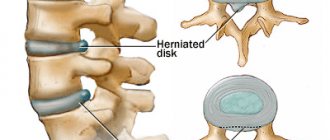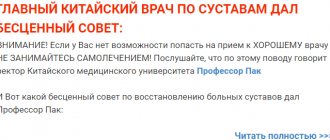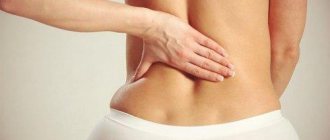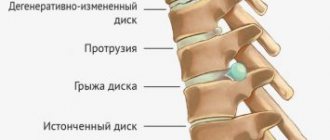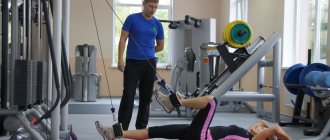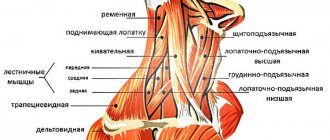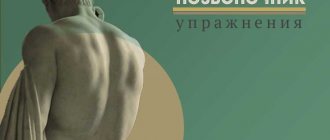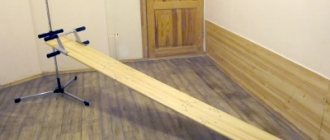An intervertebral hernia is a protrusion of the fibrous ring, which can result in its rupture. As a result, the nerve endings of the spinal cord are compressed, which provokes severe pain and disturbances in the functioning of internal organs. This pathology can appear in any part of the spine, however, most often it is localized in the lumbosacral region. One of the main methods of treatment is gymnastics for lumbar hernia. With its help, you can improve the condition of ligaments and strengthen muscle tissue, which will prevent exacerbations of the disease.
Where does a hernia come from?
If you don’t go into details (not everyone is familiar with the anatomy of the spine), then a hernia is the release of part of the contents of the intervertebral disc beyond its anatomical limits. A very crude explanation, but understandable.
Between the vertebrae there is cartilage, which provides shock absorption when walking and performs a number of other functions. This is also where the spinal nerves pass. When the nerves are pinched by the vertebrae, we feel pain and our arms and legs go numb.
When cartilage or an intervertebral disc is damaged and extends beyond its anatomical boundaries (a hernia is formed), the likelihood of nerve entrapment becomes even greater than with its normal deformation (protrusion).
Cartilage damage always occurs due to non-anatomical or too high physical activity and weakness of the muscle corset. If, for example, an untrained person carries bags of cement weighing 50 kg each, his lower back will definitely hurt. The most harmless thing that can happen is a slight protrusion. If a person continues to lift the bags, the protrusion will imperceptibly, but very likely, turn into a hernia.
In women, hernias can even appear due to carrying buckets of water (10–12 liters each) in one hand. But all this does not appear immediately. With a vertebral hernia, pain appears when its size begins to really cause inconvenience to the nerve pathways.
Constant pain in the lower back indicates that the process has been developing for a long time and has reached its climax. Perhaps you did not consider earlier, periodic pain as a variant of a problem in the lumbar spine. So be more attentive to your feelings. Pain is a beacon in the ocean. If we don't pay attention to it, we'll drown.
Main rules of exercise therapy
It is quite understandable that when such back pathologies are detected, the patient seeks to remove the symptom - pain, because such discomfort disrupts the usual schedule of life activities. But often the problem is ignored and neglected—removing the symptom of the disease does not eradicate its cause. With prolonged absence of therapy, it is likely that the pathology will progress to the point where surgical intervention is the only option.
What to do if there are no resources or time for expensive and lengthy rehabilitation? For this purpose, there is therapeutic exercises for hernia of the lumbar spine - this is a very effective method despite the duration of therapy and the requirement for systematic exercise.
How does physical therapy work for a hernia:
- Improves blood flow in the problem area.
- Reduces the intensity of pain.
- Removes muscle spasm.
- Has a general strengthening effect on the muscle corset.
- Inhibits the source of inflammation.
You can resort to gymnastics for a lumbar hernia only after a full examination by a specialist - it is he who will prescribe a course of exercises appropriate in the case of pathology and supplement it with auxiliary physiotherapy procedures or medications.
In order for physical education for a hernia of the lumbar spine to bring benefits and not aggravate the health situation, it is necessary to adhere to the following rules of therapy:
- Do not perform exercises that cause severe pain.
- Gradually increase the load (intensity, duration and complexity of the workout).
- Avoid sudden, jerky movements. Avoid running and jumping.
- Perform the complex in parts, alternate their implementation. It is also recommended to do several approaches per day.
- Maintain periodicity and systematicity (the result will not be noticeable so quickly).
- Do not exercise to the point of exhaustion. Pleasant fatigue after training is an acceptable feeling.
- If physical exercise causes a deterioration in your health (discomfort, loss of sensitivity, numbness, sensation of “goosebumps”), then you should stop exercising and consult a doctor.
- Before starting a workout, a massage using a warming ointment is recommended.
A correctly selected and carefully performed set of physical activities will give noticeable results no sooner than after 14 days of systematic exercise. By using physical education for a herniated lumbar spine on an ongoing basis, you can forget about pain forever.
When to start gymnastics
Practice shows that, as a rule, protrusions of cartilage in the spine are one-sided. Accordingly, with a hernia, pain is felt in the lower back and arm or leg (on one side).
A person reflexively tries to take a pain-free position. As a result, curvatures of the spine are formed due to reflex muscle spasms. Unconscious control of the muscular system effectively isolates the sore spot, making some movements impossible.
Therefore, the first thing to do in case of a hernia is to relieve pain.
The hernia can go away on its own if conservative treatment is provided correctly. If you just wait until it all goes away on its own, over time it can lead to irreversible consequences. It happens that the hernia is so large that simply relieving the pain is useless. They perform an operation.
After pain is relieved, depending on the situation, the patient is prescribed spinal stretching or exercise therapy. It is imperative to do exercises to strengthen your back muscles. As soon as you can do them, you need to start.
Contraindications and general advice
Therapeutic gymnastics, like any therapeutic measure, has a number of contraindications:
- early postoperative period (gymnastics after removal of a protrusion is indicated only on the recommendation of a doctor);
- oncological formations;
- hypertensive crisis;
- hyperthermia (high temperature);
- period of exacerbation (a gentle program is acceptable);
- pre-infarction state.
You can achieve a positive effect and consolidate the results for a long time only by systematically performing exercises. In addition, you need to adjust your lifestyle and leisure time to avoid exacerbations:
- avoid overheating or hypothermia of the lower back;
- sleep on an orthopedic mattress;
- avoid sudden and strong loads on the spine;
- when lifting objects, correctly distribute the load on the body (do not lift by bending over);
- avoid movements that cause pain.
Systematic exercises and daily caution will help you forget about lower back pain and lead a normal life, not constrained by pain and discomfort.
A set of exercises for rehabilitation
So, let's look at what exercises can and should be done. The complex below does not require any additional equipment other than a mat.
Once you start doing a set of exercises for a hernia, you can place a soft cushion 3–4 cm high under your lower back. If you feel good without it, you can do it without a cushion.
All physical exercises for spinal hernia are performed according to sensations. If a movement hurts, put it off for another time.
Belly breathing
We lie with our backs on the floor, knees bent, hands folded on the stomach.
- Take 10 quality breaths in and out, inflating your belly.
In this exercise you will stretch your core muscles and diaphragm. We breathe slowly and control it with our hands so that the stomach inflates and deflates.
Abduction of arms and legs
Again, back on the floor, knees pointing to the ceiling, straight arms lying along the torso.
- Straighten one leg, then move it to the side. Parallel to it, move the straightened arm of the other side to the side.
- Move your leg back and bend it, and return your straight arm to its original position.
- The recommended number of repetitions is 10 times.
These are exercises for stretching muscles that were under pressure from spasms, plus coordination.
Crossing your legs over your legs
We lie with our backs on the floor, bending our legs and resting our heels on the floor. Hands clasped behind head.
- One leg was straightened, placed on the other, and bent.
- Then it was straightened and returned to its original position.
- Then we do the same with the second leg.
- 10 times on each leg.
The exercise strengthens and stretches the abdominal muscles.
Another variation of this exercise for the back with a herniated disc is to reach with your hand towards the heel of the opposite leg when this leg is crossed over the knee. This is a slightly more complicated option.
Rotate your feet
We lie on our backs, arms bent at the elbows, so that the hands are in the air.
- The legs were straightened and slightly spread to the sides. At the same time, rotate your feet and hands in one direction.
- We made 5 circles - we rotate to another.
Calf stretch
We lie down with our hands behind our heads. One leg is bent at the knee, and the other is straight.
- We pull the toe of the straight leg towards ourselves for about 10 seconds to stretch the calf muscle.
- Then this is an exercise for the second leg.
- Repeat 5 times.
Wrapping your hands around your knees
A more complex version of the exercise for intervertebral hernia is to alternately clasp your knees with your hands.
- From a lying position, arms outstretched to the sides, and legs bent at the knees, raise one knee to the chest.
- We grab it with our hands and pull it towards ourselves. Then we repeat the same movement with the other knee.
- 5-8 times for each knee.
Sliding hands on thighs
The exercise is also performed on the floor.
- From a lying position, slide the palm of one hand down the thigh, bending the body in the appropriate direction. The second hand slides up the opposite side of the body.
- We perform the movement slowly, to the right and left alternately.
- Repeat 5-8 times in each direction.
The further you can reach with your hand (all the way to your knee), the better.
Lying knee rotations
We lie on our backs, hands behind our heads, legs bent at the knees.
- We lower our knees to one side, to a comfortable limit, and raise them back. Then we lower it to the other side - we return to the starting position.
- Try to keep your heels off the floor so your legs don't hang in the air. It may hurt.
- Repeat 10 times in each direction.
House
This exercise develops stretching, and your body looks like a house with a triangular roof.
- They turned over on their stomachs, stood on all fours, with their toes pointing to the floor. Keep your back straight.
- Raise your pelvis and pull it up until an angle is formed between your body and legs. The back should be straight.
- Don't try to straighten your legs by rounding your back. Let your legs remain slightly bent.
- We stood in this position for 5–10 seconds and returned to the starting position. Repeat 5 times.
If you can do this exercise, very good! If not, you can later.
Sliding knee to hand
We stand on our knees and hands.
- Move your right knee across the floor towards your left hand.
- Bring it back.
- Do the same for the other hand.
- 10 times for each knee.
Leg Raising
We get on our knees and elbows.
- Without changing the angle of the knee, we raise one leg, then lower it.
- We do 10 lifts.
- Then we raise the other leg 10 times.
At first, movement may be painful. We do it with painless amplitude.
Stretching and balance
We stand on 2 limbs - a leg (knee) and an arm (on opposite sides of the body).
- We straighten the opposite leg and move it back, and the arm, respectively, forward.
- Hold for 10 seconds and change sides. Repeat 5 times.
Leg abduction to the side
We lie down on our side so that it is comfortable. Legs should be straight and lie on top of each other.
- Raise the leg that is on top and lower it back. Repeat 10 times.
- Then we turn over and repeat the movements for the other leg.
"Rainbow"
This movement is sometimes called the "cat exercise." We stand on all fours. Arms are straight, palms facing forward. Head straight.
- We lower our head down, and at the same time bend our back up.
- There should be a single arc - from the head to the tailbone. Let's go back.
- Let's make 10 of these rainbows. Slowly.
Bubnovsky’s gymnastics for lumbar hernia of the spine
The best therapeutic gymnastics for the spine is considered to be the gymnastics of Professor Sergei Mikhailovich Bubnovsky. He was able to integrate the best techniques for healing the spine into a general set of exercises, while creating a new method of effective recovery. This technique has already helped thousands of people suffering from herniated discs.
When using this simple therapeutic exercise, it is possible to do even without a surgical operation to remove a hernia!
Sergei Mikhailovich developed this unique technique based on his own experience. After the accident, doctors said that he would become disabled and there were no guarantees of recovery. Then Bubnovsky began to study the many years of experience of the world's leading experts and all kinds of practices. Over time, he healed himself and began to share his knowledge around the world.
The professor is 100% sure that the lack of stress and rest recommended by other doctors only interfere with recovery. The treatment recommended by Sergei Mikhailovich helps to improve the body’s health without surgery or other medications. He promotes the healing power of movement. Only movement, in his opinion, helps to awaken the internal forces of the body and allow it to get rid of the disease.
The treatment method itself is based on the following 5 principles.
Complete muscle relaxation . This allows the patient to relieve swelling, inflammation and pinched nerve endings, which cause terrible pain.
Working out all the muscles of the body and especially those that work very little in everyday life. This will speed up metabolism and blood circulation in the affected areas of the back.
Stretching the spine and muscles . Then they become elastic, healthy and retain their youth for a long time. The spine itself straightens, and the displaced vertebrae fall into place over time. Stretching exercises can improve the patient's mobility and quality of life.
Strengthening the muscular frame. It is necessary to perform exercises in a complex so that the muscles of the back, abdominals and pelvis are involved. In parallel - the muscles of the arms and legs.
Lack of medications. Back pain due to hernias is relieved by physical activity. Already in the first sessions, patients begin to notice improvements and feel better.
Despite the positive results, Bubnovsky’s therapeutic gymnastics exercises for the spine are not suitable for everyone. They are prohibited for a number of diseases and pathologies:
- an oncological disease, especially if metastases have spread to the vertebral area;
- hypertensive crisis and circulatory disorders in the brain
- it is forbidden to start exercises in the early stages of recovery after hernia surgery;
- the Bubnovsky method cannot be used in a pre-infarction state and with unstable angina.
So what should you do if you have a herniated disc? The doctor himself recommends taking a course of kinesitherapy (from Latin “motion treatment”) on the simulators designed for this. This can be done in specialized centers, which are found in most large cities. In Voronezh for sure!
The key to training effectiveness
Exercises for the spine with a hernia are so diverse that it is easier to convey their principle than to list everything.
As you understand, the above is only a small part of all existing options.
Graduality
The first stage is the initial restoration of leg mobility and muscle stretching. All movements are performed so that the lower back does not receive much load.
The next stage - you can already perform pelvic lifts, pumps, folds with legs bent at the knees and a slight lifting of the body.
The main thing is to gradually strengthen the muscles so as not to get negative consequences.
Stability and regularity
Consistency in practice is a guaranteed result. If you exercise consistently for a month, you will definitely feel better.
It’s worth saying right away that if, after feeling relief, you stop exercising, the pain will most likely return. After all, the muscles will weaken without training, and the hernia will make itself felt again. Gymnastics is now your constant companion. You can change the exercises, gradually making them more difficult. But you just need to do it several times a week.
If you have a herniated spine, exercise is the key to your well-being. You can live your whole life with a hernia and without pain.
How to determine a hernia?
There are symptoms typical for a hernia, the manifestation of which can determine the pathology:
- Increased pain is observed in the lumbar region. If the load increases, the pain becomes unbearable.
- Sensitivity is significantly reduced, and numbness is felt in the limbs.
- Once the hernia has formed, it will be very difficult for the patient to move independently.
- There is a shooting pain in the buttocks area. Often, irradiation of pain can occur in the fingers of the lower extremities.
- There are problems with knee reflexes.
- At an advanced stage of the disease, symptoms such as difficulty urinating, sometimes spontaneous urination, and problems with the pelvic organs appear.
It is important! Additional symptoms will depend on the direction of the protrusion. When this pathological process occurs to the sides or forward, there is a high probability of disruption of the functionality of internal organs. In case of protrusion inward, the main damage will be caused to the spinal canal, which can ultimately be fatal.
Symptoms of intervertebral hernia
General recommendations
Exercises for the back with a hernia cannot be chosen independently, otherwise there is a risk of worsening the condition. The complex is always selected individually, after an examination has been carried out to identify the cause of the development of the disorder. During the period of exacerbation or development of the inflammatory process, motor activity is completely excluded or limited. You can start doing gymnastics only after your condition has stabilized.
Exercises are performed in compliance with the following rules:
Dikul gymnastics for the spine with a hernia
- It is forbidden to make sudden lunges, turns or forceful impacts. All movements are slow, with controlled breathing, aimed at tracking internal sensations.
- If acute pain in the lower back occurs, you should immediately stop training and consult a doctor.
- Classes should be carried out regularly, preferably at the same time, for example in the morning. The results obtained directly depend on consistency and adherence to the recommended schedule.
- In the first months of treatment, exercises that involve twisting the spine are not recommended.
- On average, a workout should last 20-30 minutes; longer sessions can do more harm than good.
- The load always increases gradually, taking into account the general physical fitness and age of the patient.
Physical training for a vertebral hernia has its own characteristics and is not similar to standard training for building muscles. Control of breathing and internal sensations is extremely important to achieve a certain result.
You should do gymnastics at the same time and in comfortable clothes.
Effective gymnastic exercises for vertebral hernias
The complex of therapeutic exercises should be selected by the patient’s attending physician, since he can sensibly assess his condition and set the goals for physical education.
Here are some effective and simple exercises that are widely used in rehabilitation for lumbar hernias. They are easy to implement, so they are suitable for patients with almost any level of physical development. The exercises are safe to perform, so doctors often recommend including them in a complex of physical therapy.
